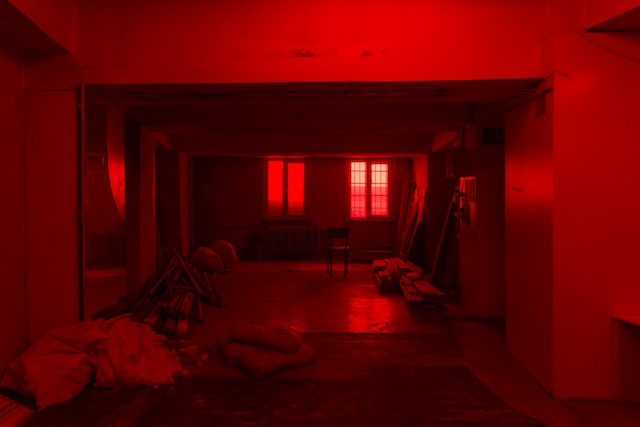The seventh floor of Gürün Han, the modernist commercial building that hosts Mike Nelson’s Kafkaesque installation, is a warren of offices and storerooms connected by dimly lit corridors. The majority of these spaces are vacant, the wholesalers they once housed having suffered from the decline of the textile industry for which Istanbul was once famous. But a few remain in use, and through an open door I spy a young man in overalls stacking vacuum-packed shirts into neat piles on the floor.
Other rooms suggest a more ominous presence: several whitewashed shopfronts are backlit by a sinister red glow, while a dozen or so – bare floorboards flecked with paint, obsolete calendars tacked to walls watched over by fading portraits of Atatürk – have been converted into makeshift screening rooms, showing short videos shot from the backseats of local taxis. Projected at different sizes onto walls or played through monitors, they are variations on the same theme: the back of the driver’s head, the meter ticking through, the unspooling streets of Istanbul. These enigmatic interventions into the architecture are neither explained nor signposted, so I push at locked doors, peer into abandoned salerooms and meander around the labyrinthine arcades in search of… well, I guess I don’t know what.
The experience is a little like waking up in a sci-fi film noir and trying to figure out the plot, or of wandering round the abandoned headquarters of some vast and unresponsive bureaucracy in search of an unspecified appointment. The numerous videos, and the apparently aimless journeys they document, are displayed in curious formats: turned anticlockwise through 90 degrees, projected onto convex mirrors that bounce the distended images back onto the wall, passed through tinted filters. But to what purpose? Filmed by the artist over several visits to Istanbul, these banal chronicles of a changing city serve no obvious narrative, however much their arrangement into patterns implies – like newspaper clippings on a conspiracist’s wall – some more arcane organising principle.
If there are clues hidden amidst the clutter, they are oblique. One narrow room, in which a number of 14-inch television monitors are arranged on shelves stacked with archaic audio- visual equipment, resembles a projectionist’s workshop or surveillance centre. In a corner office bathed in red light, an empty chair stands amidst discarded mirrors and cluttered wooden beams. These red lights and dark rooms, the halls of mirrors and looping videos, might suggest a play on the stitching together of light and time by which cinema generates narrative. The feeling that some authoritarian, unaccountable and artificial intelligence is directing the complex might even be a nod to Jean-Luc Godard’s dystopian Alphaville (1965), name-checked in the exhibition literature. But, equally, it might not.
Everything is called into question: I spent several minutes wondering whether a cluttered room lit by blue bulbs was part of the exhibition or a hastily abandoned workspace. Which is, ultimately, the point. Nelson’s interventions into this functioning building work by unsettling the boundaries separating fictional construct from historical record. My abiding impression was of a protagonist having recently fled the scene, leaving behind (amidst the ‘meaningless’ detritus) a set of ‘meaningful’ clues from which it might be possible to patch together an incomplete version of what happened.
I won’t be the only person to have recently been frustrated by artists acting under the impression that disorientating the viewer is an end in itself; equally, I resent any work of art that assumes it is the responsibility of the visitor to deduce whatever easily articulated concept or conclusion the artist has chosen for no clear reason to withhold. But Nelson’s existentialist detective fiction stayed with me for days because it neither revels in obscurity nor offers up a reassuring resolution: the promise of revelation is always held out, while remaining just beyond reach.
Mike Nelson: Projektör (Gürün Han) with Protocinema, Istanbul, 2 May – 1 June
From the Summer 2019 issue of ArtReview
